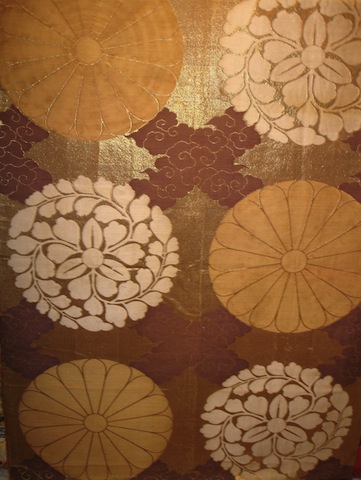By: Carol Gil
Through Labor Day 2012, the Petterson Museum of Intercultural Art is Celebrating the Traditional and Modern Arts of Japan with over 150 objects on display. The museum has almost 1300 Japanese artifacts from which we have selected a small sampling to represent various aspects of life in Japan in the last two centuries. Clothing and accessories, textiles, prints, musical instruments, ceramics, scrolls, metalwork, masks, figurines, dolls, tools and household utensils from the early 18th to the late 20th century are on view.
 One of the treasures currently on display is a fragment of an imperial obi. The story of how it came to the museum is typical of many of our artifacts. It was donated in 1977 by Richard and Alice Petterson, the museum’s founders. They had purchased it at the Pilgrim Place Festival held at the retirement community of the same name, to raise money for their Health Services program and where the eponymous Petterson Museum is now located. The Festival in some respects is like a giant yard sale. Residents of Pilgrim Place and the wider community contribute items for sale for the annual charity event. The Pettersons, in their efforts to research the history of the silk and gold textile they had purchased “decided to create a group of interested persons who would undertake the collecting and preservation of Pilgrim Place treasures.” Thus was born the idea of creating what would become the Petterson Museum at Pilgrim Place.
One of the treasures currently on display is a fragment of an imperial obi. The story of how it came to the museum is typical of many of our artifacts. It was donated in 1977 by Richard and Alice Petterson, the museum’s founders. They had purchased it at the Pilgrim Place Festival held at the retirement community of the same name, to raise money for their Health Services program and where the eponymous Petterson Museum is now located. The Festival in some respects is like a giant yard sale. Residents of Pilgrim Place and the wider community contribute items for sale for the annual charity event. The Pettersons, in their efforts to research the history of the silk and gold textile they had purchased “decided to create a group of interested persons who would undertake the collecting and preservation of Pilgrim Place treasures.” Thus was born the idea of creating what would become the Petterson Museum at Pilgrim Place.
The obi was imperial in its origins – the 16 petal chrysanthemum motif is restricted in use to members of the royal family of Japan. The Pettersons learned it had originally been owned by Miss Frances Clapp, a retired missionary to Japan and then resident of Pilgrim Place. Ms. Clapp was born in Indiana in 1887, earned a degree in music from Pacific University, Oregon and subsequently studied music in Germany and at Columbia University. She taught piano at Pomona College from 1912-1916 before being sent to Japan by the Missionary Board of the United Church of Christ in 1918.
From 1918-1923 and again, between 1927 and March 1941, she taught organ, piano, choral music and music theory at Doshisha College in Kyoto. She spent the war years in Hawaii, witnessed the Pearl Harbor attack and “served as a buffer between the Japanese Americans and the suspicions of the white population until Japan’s surrender” during the war. One of the first missionaries to return to Japan in 1946 after the war, she continued teaching at Doshisha until her retirement in 1957. In 1965 former students in Japan arranged for her presentation to the Empress in Tokyo. At this event, the sister of the empress cut one of her obis in two and presented half to Frances in thanks for helping her to “set Buddhist scripture to western harmony”. She arrived at Pilgrim Place in 1966 where she died in 1977. Sometime during those last years, she gave her obi to be sold.








Add new comment